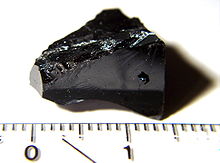Cadmium telluride
| Crystal structure | |||||||||||||||||||
|---|---|---|---|---|---|---|---|---|---|---|---|---|---|---|---|---|---|---|---|

|
|||||||||||||||||||
| __ Cd 2+ __ Te 2− | |||||||||||||||||||
| General | |||||||||||||||||||
| Surname | Cadmium telluride | ||||||||||||||||||
| other names |
Irtran-6 |
||||||||||||||||||
| Ratio formula | CdTe | ||||||||||||||||||
| Brief description |
odorless black solid |
||||||||||||||||||
| External identifiers / databases | |||||||||||||||||||
|
|||||||||||||||||||
| properties | |||||||||||||||||||
| Molar mass | 240.01 g mol −1 | ||||||||||||||||||
| Physical state |
firmly |
||||||||||||||||||
| density |
5.85 g cm −3 |
||||||||||||||||||
| Melting point |
1092 ° C |
||||||||||||||||||
| boiling point |
1121 ° C |
||||||||||||||||||
| solubility |
almost insoluble in water |
||||||||||||||||||
| safety instructions | |||||||||||||||||||
|
|||||||||||||||||||
| MAK |
0.1 mg m −3 (based on Te) |
||||||||||||||||||
| As far as possible and customary, SI units are used. Unless otherwise noted, the data given apply to standard conditions . | |||||||||||||||||||
Cadmium telluride (CdTe) is a crystalline compound from the group of Telluride consisting of cadmium and tellurium having a (cubic) sphalerite - crystal structure ( space group F 4 3 m (space group No. 216). ) Is formed. In its crystalline form it is a direct II-VI bandgap - semiconductor . CdTe is also a good solar cell material . It is usually used as a layer structure with cadmium sulfide to create a pn junction , e.g. B. to form a solar cell or photodiode .
use
CdTe is an absorber material for solar cells. Although the raw material is significantly more expensive than silicon , thin-film solar cells can be manufactured more cheaply, since the amount of CdTe required to achieve the same absorption as silicon is orders of magnitude smaller. CdTe as mixed crystal with mercury telluride HgTe forms a versatile infrared detector material (Hg, Cd) Te. CdTe as a mixed crystal with zinc telluride ZnTe forms an excellent X-ray and gamma radiation detector material (Cd, Zn) Te.
CdTe is used as a material for optical windows and lenses in the infrared range , but it has only a small area of application. Its use is limited by its harmful classification, so that only a few optics manufacturers work with CdTe. An early form of CdTe for IR use was marketed under the trade name Irtran-6 , but this is obsolete.
CdTe is also used as an electro-optic modulator . It has the highest electro-optic coefficient of linear electro-optic effect among all II-VI composite crystals .
properties
Physical Properties
- Lattice constant : 0.648 nanometers at 300 K.
- Young's modulus : 52 GPa
- Poisson's number : 0.41
Thermal properties
- Thermal conductivity : 6.2 W / (m K) at 293 K.
- Specific heat capacity : 210 J / (kg K) at 293 K.
- Thermal expansion coefficient : 5.9 × 10 −6 / K at 293 K.
Electronic properties
- The direct band gap is 1.56 eV at 300 K.
- effective mass of the electron 0.11 m e
- effective mass of the hole 0.4 m e
Optical properties
CdTe is transparent in the infrared range (from close to its band gap energy (= 795 nm) up to wavelengths greater than 20 µm). The index of refraction is 2.649 at 10 µm.
Chemical properties
CdTe is very sparingly soluble in water. It is broken down by many acids including hydrochloric and hydrobromic acids to form hydrogen telluric (poisonous) gas .
safety instructions
Cadmium telluride is harmful to health. The greatest danger is - with an absorption rate of up to 90% - when fine dust is absorbed via the respiratory tract; the absorption rate via the gastrointestinal tract, however, is only about 5%.
Related links
- Mercury Telluride (HgTe)
- Mercury (II) cadmium (II) telluride ((Hg, Cd) Te)
- Zinc telluride (ZnTe)
- Cadmium Selenide (CdSe)
- Cadmium zinc telluride ((Cd, Zn) Te)
Individual evidence
- ↑ a b c data sheet cadmium telluride from AlfaAesar, accessed on December 15, 2010 ( PDF )(JavaScript required) .
- ↑ Peter Capper: Properties of Narrow Gap Cadmium-Based Compounds 1994, ISBN 0-85296-880-9 .
- ↑ RF Brebrick: Thermodynamic modeling of the Hg-Cd-Te and Hg-Zn-Te system . In: Journal of Crystal Growth . tape 86 , no. 1 , 1988, p. 39-48 , doi : 10.1016 / 0022-0248 (90) 90696-I .
- ↑ Safety data sheet (testbourne) ( Memento from February 15, 2010 in the Internet Archive )
- ↑ a b c Entry on cadmium telluride in the GESTIS substance database of the IFA , accessed on February 1, 2016(JavaScript required) .
- ↑ Not explicitly listed in Regulation (EC) No. 1272/2008 (CLP) , but with the specified labeling it falls under the group entry Cadmium compounds in the Classification and Labeling Inventory of the European Chemicals Agency (ECHA), accessed on February 1, 2016 . marketer can use the harmonized classification and labeling expand .
- ^ Novel Techniques Examine Solar Cells with Nanoscale Precision. NIST , June 9, 2017, accessed June 16, 2017 .
- ↑ Solar Power lightens Up with Thin Film Technology. Scientific American , April 25, 2008, accessed July 8, 2019 .



